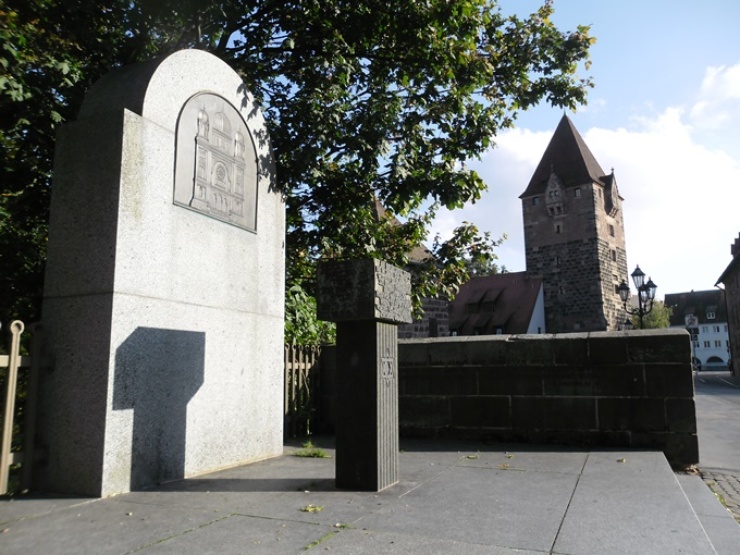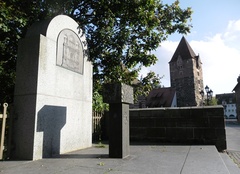Nurnberg
Pronounced “NOORN-berg” (English: Nuremberg, Hebrew: נירנברג / Nirnberg )
The first known Jewish residents of Nürnberg arrived in the late 1100s seeking refuge from the Second Crusade. In 1280, this early community consecrated its first synagogue. However, over the next two centuries the city council and nobility periodically forced Jews to leave the city. Jews would be allowed to return only when authorities needed the income received from the high taxes and fees demanded of Jewish residents. When allowed in Nürnberg, Jews were limited to living within a segregated area and faced restrictions on their trade, business and way of life.
Antisemitic prejudice sometimes erupted into mass violence. In 1298, more than 700 Jews were murdered after being accused of desecrating the bread used in Christian rite of communion. More massacres followed around 1349 when Jews were blamed for the Black Death. Some 560 Jewish residents were murdered. Most Jewish homes were destroyed and a church was built on the market square where the synagogue once stood. In 1499, all Jewish residents were forced to leave and no Jews were allowed to live in the city for more than three hundred years.
It was not until 1850 that the Nürnberg town council accepted a Jewish man as a citizen. The Jewish population then grew from about 220 in 1858 to approximately 5,600 at the end of the century. A Jewish cemetery opened in 1864 and the Grand Synagogue was inaugurated 10 years later. The Grand Synagogue adhered to Reform practices, but a separate congregation of more traditional Orthodox believers established their own synagogue in 1901.
Another synagogue was founded in Nürnberg in 1917 to serve the community of Jewish immigrants from eastern Europe. Sadly, the 1920s saw a resurgence of popular anti-Jewish sentiment. From 1922 to 1933 the city received more than 200 reports of damage to Jewish cemeteries. In 1923, Nazi propagandist Julius Streicher founded the antisemitic “Der Stürmer” newspaper and the Nazi Party held the first of several party rallies in Nürnberg in 1927.
By the time Hitler was appointed Chancellor of Germany in January 1933, the Jewish community of Nürnberg (approximately 9,000 of 410,000 total residents) was the second largest in the region of Bavaria. That July, hundreds of Jewish men were arrested and forced to a local soccer field. Survivor Fred Rodell, 13 years old at the time, witnessed as the men “were cutting the grass … with their mouths.” In September 1935 the Nazi party passed the Nuremberg Laws stripping Jews and other minorities of German citizenship and rights.
On the order of Nazi leader Julius Streicher, the Great Synagogue of Nürnberg was demolished on August 10, 1938. Three months later, the two other main synagogues of the city were razed during the pogrom of Kristallnacht. Nazis vandalized, looted and destroyed Jewish-owned property and businesses. Some 160 Jews were arrested and 16 were murdered.
Thousands of Jewish citizens, including Fred Rodell and his mother, managed to escape Nürnberg before World War II started in September 1939. Between November 1941 and September 1942, roughly 1,500 Jews who remained in the city were deported to concentration camps. Of these, fewer than 50 survived. In autumn 1942, the Nazis declared the city “Judenrein”—free of Jews.
From 1943 to 1945, Allied air forces conducted strategic bombing campaigns against Nürnberg, a key site of German military production. After the war, the Allied governments conducted the Nuremberg trials in which Nazi officials faced judgment for war crimes and crimes against humanity. After serving with the U.S. military, Survivor Fred Rodell came back to Nürnberg as a translator and interrogator.
Only about 65 Jews returned to live in Nürnberg.
Nurnberg: Photographs & Artifacts
-
 Memorial for the Jewish synagogue in Nuremberg, October 2012. Wikimedia Commons / Aarp65 / CC-BY-SA 3.0
Memorial for the Jewish synagogue in Nuremberg, October 2012. Wikimedia Commons / Aarp65 / CC-BY-SA 3.0
Destroyed Communities Memorial Slope
Nurnberg: Survivors
Because of [my father’s] foresight and planning, my parents and I were able to leave before Kristallnacht.
They arrested all the Jews for one day. … When we got there, we saw the soccer field. They had their hands behind their back and were cutting the grass by biting the grass off with their mouths.
